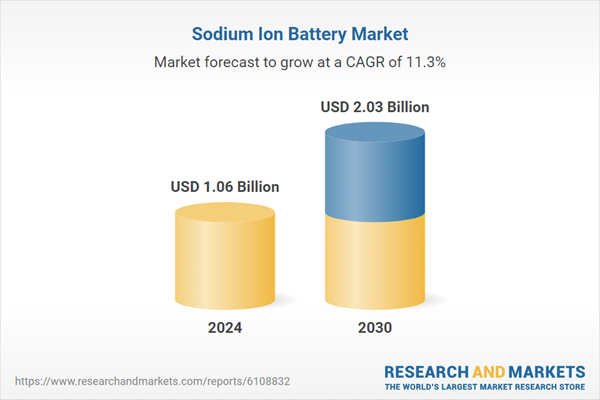Speak directly to the analyst to clarify any post sales queries you may have.
10% Free customizationThis report comes with 10% free customization, enabling you to add data that meets your specific business needs.
Unlike lithium, which is geographically concentrated and often costly, sodium is abundantly available worldwide, typically sourced from common salt. This lowers supply chain risks and supports broader adoption across energy storage and mobility applications. The growing need for reliable, cost-effective energy storage - especially for renewable energy integration - is accelerating interest in sodium ion technologies. With favorable thermal stability and lower risk of thermal runaway, sodium ion batteries are increasingly being deployed in stationary grid storage and are also being considered for light electric vehicles in price-sensitive markets, notably in Asia and South America.
Key Market Drivers
Increasing Demand for Sustainable Energy Storage Solutions
The global transition toward clean energy is driving the demand for sustainable and scalable storage solutions, positioning sodium ion batteries as a strong contender in grid and utility applications. Sodium, being abundant and widely distributed, offers a key advantage over lithium and cobalt, whose sourcing raises concerns related to scarcity, cost, and environmental impact.These batteries align with global climate targets and evolving regulatory frameworks focused on sustainability and resource efficiency. Their inherent safety, due to better thermal stability and non-toxic components, makes them particularly suitable for long-duration and stationary applications. As decarbonization initiatives accelerate worldwide, sodium ion batteries are being embraced as an eco-friendly storage technology for balancing renewable energy supply and grid reliability.
Key Market Challenges
Lower Energy Density Compared to Lithium-ion Alternatives
A primary limitation impeding wider adoption of sodium ion batteries is their lower energy density relative to lithium-ion counterparts. Sodium’s larger ionic radius and slower ion mobility reduce energy storage efficiency and impose restrictions on performance, especially in space- and weight-sensitive applications such as electric vehicles and consumer electronics.This challenge stems from the structural constraints of current electrode materials, which struggle to maintain performance over multiple charge-discharge cycles when used with sodium ions. Despite progress in material science - including hard carbon anodes and layered oxide cathodes - achieving energy densities on par with lithium-ion batteries remains a significant technical barrier, particularly for high-performance sectors.
Key Market Trends
Rapid Integration of Sodium Ion Batteries into Stationary Energy Storage Systems
One of the most significant trends shaping the Sodium Ion Battery Market is its growing integration into stationary energy storage systems. As solar and wind power installations expand, the need for stable and scalable storage solutions to mitigate intermittency and ensure grid resilience is intensifying. Sodium ion batteries, known for their cost-effectiveness, wide temperature tolerance, and safety, are being increasingly deployed in utility-scale storage and rural microgrid applications.This trend is bolstered by supportive government policies and pilot programs across Europe and Asia aimed at diversifying storage technologies. In China, for example, sodium ion-based grid storage systems have been piloted successfully since 2024. Manufacturers are now developing modular battery units tailored for energy storage applications, further supporting commercialization. As the energy transition continues, sodium ion batteries are gaining strategic relevance as a low-cost and sustainable storage option.
Key Market Players
- Contemporary Amperex Technology Co., Limited (CATL)
- Natron Energy
- Faradion Limited
- HiNa Battery Technology Co., Ltd.
- Altris AB
- Tiamat Energy
- NGK Insulators Ltd.
- AMTE Power plc
- Aquion Energy
- Zhejiang Chuanyi Energy Technology Co., Ltd.
Report Scope:
In this report, the Global Sodium Ion Battery Market has been segmented into the following categories, in addition to the industry trends which have also been detailed below:Sodium Ion Battery Market, By Type:
- Sodium-Sulfur Batteries
- Sodium-Salt Batteries
- Sodium-Air Batteries
- Sodium-Solid-State Batteries
Sodium Ion Battery Market, By Technology:
- Aqueous Sodium Ion Battery
- Non-Aqueous Sodium Ion Battery
Sodium Ion Battery Market, By End-User:
- Automotive
- Power and Utilities
- Consumer Electronics
- Industrial
- Renewable Energy
Sodium Ion Battery Market, By Region:
- North America
- United States
- Canada
- Mexico
- Europe
- Germany
- France
- United Kingdom
- Italy
- Spain
- South America
- Brazil
- Argentina
- Colombia
- Asia-Pacific
- China
- India
- Japan
- South Korea
- Australia
- Middle East & Africa
- Saudi Arabia
- UAE
- South Africa
Competitive Landscape
Company Profiles: Detailed analysis of the major companies present in the Global Sodium Ion Battery Market.Available Customizations:
With the given market data, the publisher offers customizations according to a company's specific needs. The following customization options are available for the report.Company Information
- Detailed analysis and profiling of additional market players (up to five).
This product will be delivered within 1-3 business days.
Table of Contents
Companies Mentioned
- Contemporary Amperex Technology Co., Limited (CATL)
- Natron Energy
- Faradion Limited
- HiNa Battery Technology Co., Ltd.
- Altris AB
- Tiamat Energy
- NGK Insulators Ltd.
- AMTE Power plc
- Aquion Energy
- Zhejiang Chuanyi Energy Technology Co., Ltd.
Table Information
| Report Attribute | Details |
|---|---|
| No. of Pages | 185 |
| Published | July 2025 |
| Forecast Period | 2024 - 2030 |
| Estimated Market Value ( USD | $ 1.06 Billion |
| Forecasted Market Value ( USD | $ 2.03 Billion |
| Compound Annual Growth Rate | 11.2% |
| Regions Covered | Global |
| No. of Companies Mentioned | 10 |









